Literature Review: Nurses' Perception of Communication Barriers
VerifiedAdded on 2022/12/19
|10
|2903
|41
Literature Review
AI Summary
This literature review explores the critical role of effective communication in the nurse-patient relationship, emphasizing its impact on patient satisfaction and care quality. The review synthesizes findings from various studies, identifying key barriers to communication, including lack of knowledge and experience among nurses, the impact of workload and nursing staff shortages, and the influence of language barriers. Several studies highlight the importance of education and training for nurses in communication skills to improve care quality and patient outcomes. The analysis covers the effects of inadequate equipment, poor infrastructure, and the significance of interpersonal relationships. The review concludes that addressing these communication challenges is essential for enhancing the therapeutic relationship and improving overall healthcare delivery.
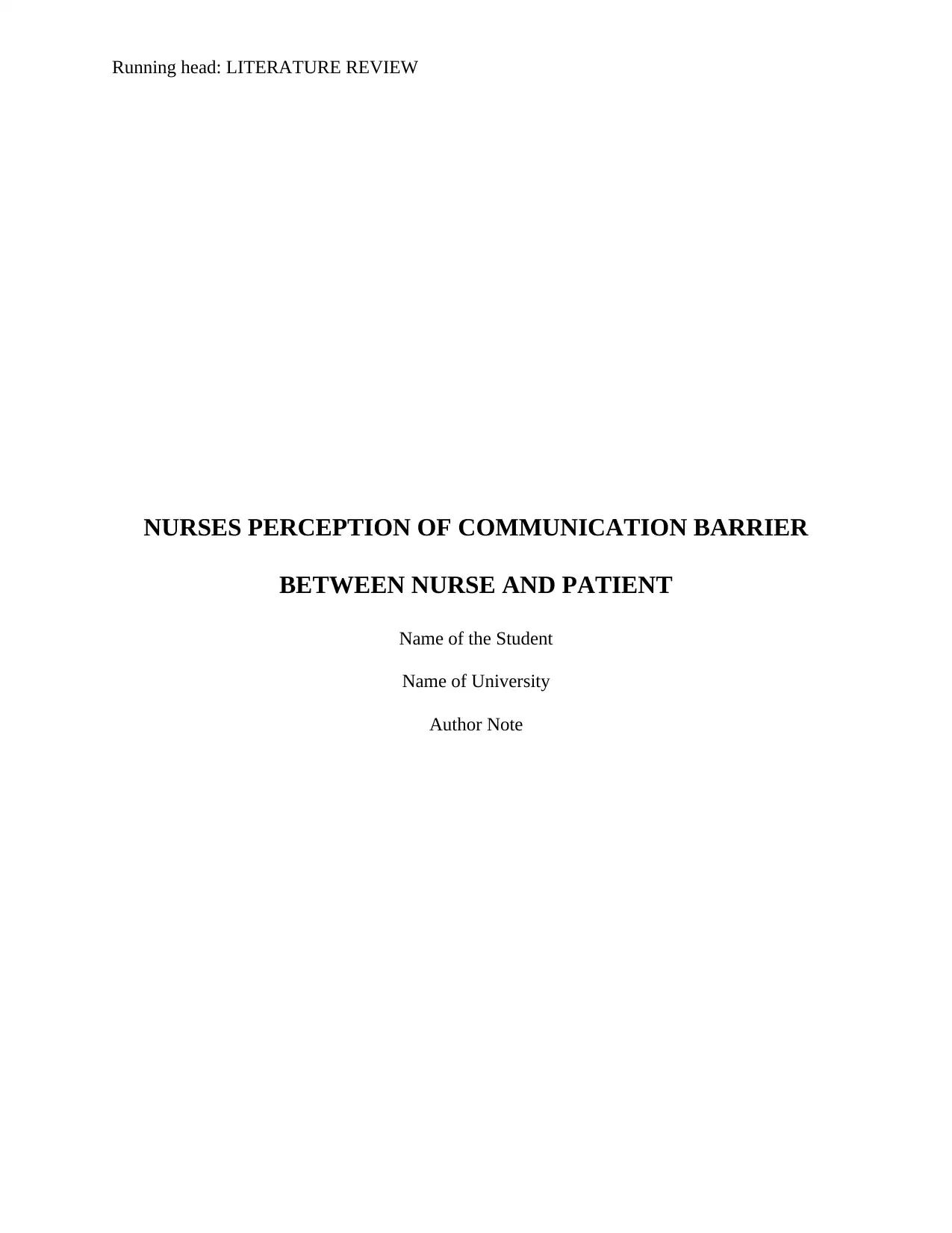
Running head: LITERATURE REVIEW
NURSES PERCEPTION OF COMMUNICATION BARRIER
BETWEEN NURSE AND PATIENT
Name of the Student
Name of University
Author Note
NURSES PERCEPTION OF COMMUNICATION BARRIER
BETWEEN NURSE AND PATIENT
Name of the Student
Name of University
Author Note
Paraphrase This Document
Need a fresh take? Get an instant paraphrase of this document with our AI Paraphraser
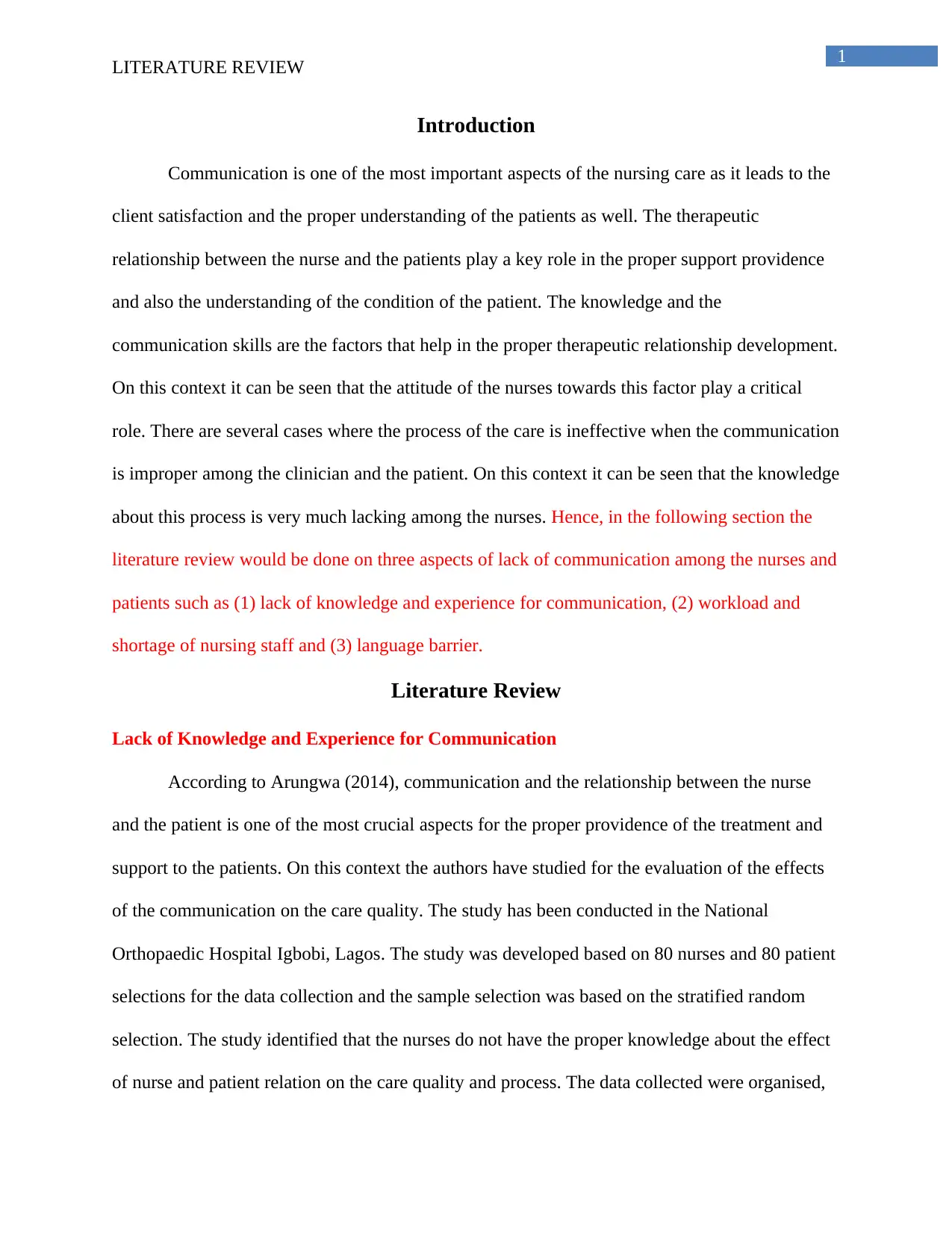
1
LITERATURE REVIEW
Introduction
Communication is one of the most important aspects of the nursing care as it leads to the
client satisfaction and the proper understanding of the patients as well. The therapeutic
relationship between the nurse and the patients play a key role in the proper support providence
and also the understanding of the condition of the patient. The knowledge and the
communication skills are the factors that help in the proper therapeutic relationship development.
On this context it can be seen that the attitude of the nurses towards this factor play a critical
role. There are several cases where the process of the care is ineffective when the communication
is improper among the clinician and the patient. On this context it can be seen that the knowledge
about this process is very much lacking among the nurses. Hence, in the following section the
literature review would be done on three aspects of lack of communication among the nurses and
patients such as (1) lack of knowledge and experience for communication, (2) workload and
shortage of nursing staff and (3) language barrier.
Literature Review
Lack of Knowledge and Experience for Communication
According to Arungwa (2014), communication and the relationship between the nurse
and the patient is one of the most crucial aspects for the proper providence of the treatment and
support to the patients. On this context the authors have studied for the evaluation of the effects
of the communication on the care quality. The study has been conducted in the National
Orthopaedic Hospital Igbobi, Lagos. The study was developed based on 80 nurses and 80 patient
selections for the data collection and the sample selection was based on the stratified random
selection. The study identified that the nurses do not have the proper knowledge about the effect
of nurse and patient relation on the care quality and process. The data collected were organised,
LITERATURE REVIEW
Introduction
Communication is one of the most important aspects of the nursing care as it leads to the
client satisfaction and the proper understanding of the patients as well. The therapeutic
relationship between the nurse and the patients play a key role in the proper support providence
and also the understanding of the condition of the patient. The knowledge and the
communication skills are the factors that help in the proper therapeutic relationship development.
On this context it can be seen that the attitude of the nurses towards this factor play a critical
role. There are several cases where the process of the care is ineffective when the communication
is improper among the clinician and the patient. On this context it can be seen that the knowledge
about this process is very much lacking among the nurses. Hence, in the following section the
literature review would be done on three aspects of lack of communication among the nurses and
patients such as (1) lack of knowledge and experience for communication, (2) workload and
shortage of nursing staff and (3) language barrier.
Literature Review
Lack of Knowledge and Experience for Communication
According to Arungwa (2014), communication and the relationship between the nurse
and the patient is one of the most crucial aspects for the proper providence of the treatment and
support to the patients. On this context the authors have studied for the evaluation of the effects
of the communication on the care quality. The study has been conducted in the National
Orthopaedic Hospital Igbobi, Lagos. The study was developed based on 80 nurses and 80 patient
selections for the data collection and the sample selection was based on the stratified random
selection. The study identified that the nurses do not have the proper knowledge about the effect
of nurse and patient relation on the care quality and process. The data collected were organised,
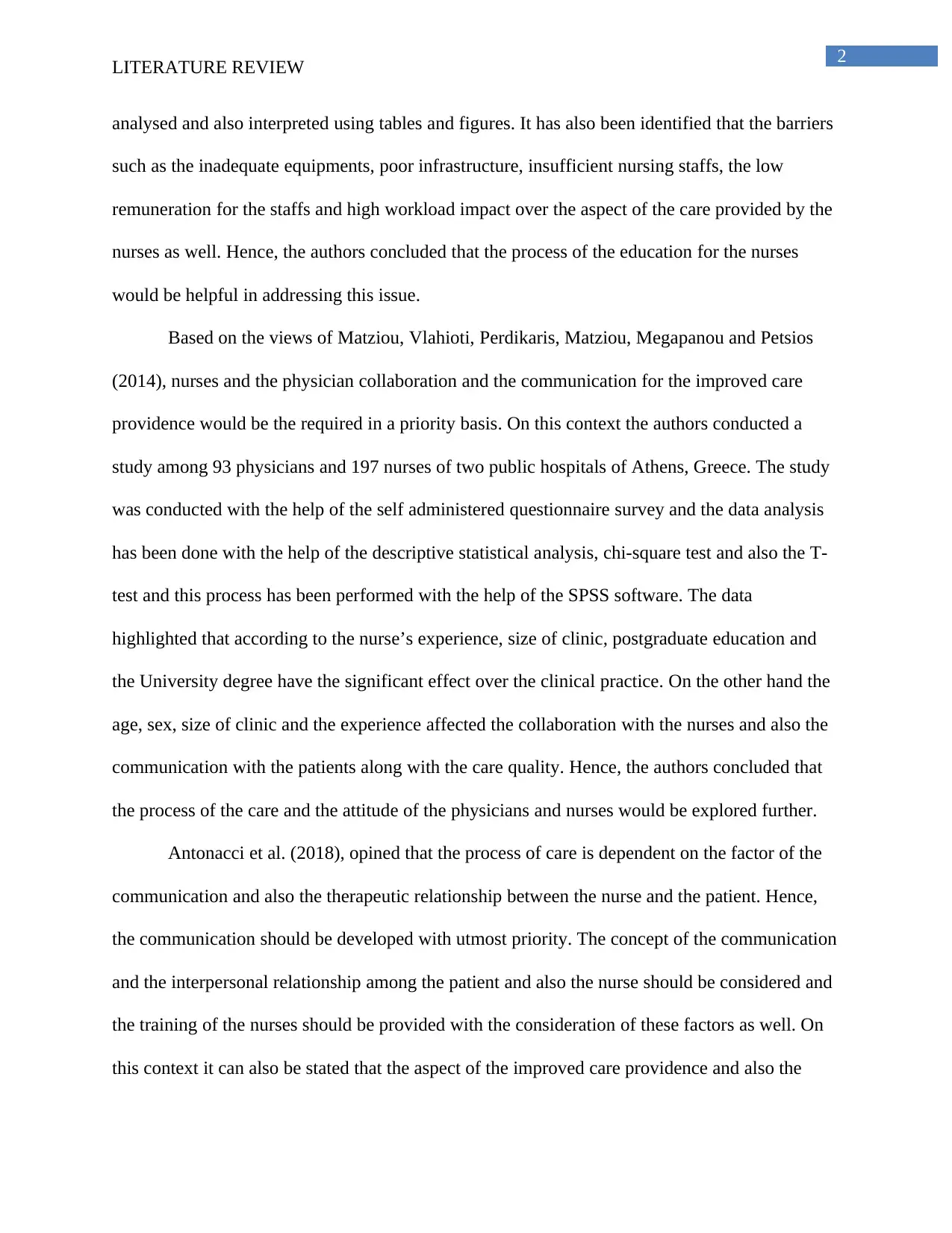
2
LITERATURE REVIEW
analysed and also interpreted using tables and figures. It has also been identified that the barriers
such as the inadequate equipments, poor infrastructure, insufficient nursing staffs, the low
remuneration for the staffs and high workload impact over the aspect of the care provided by the
nurses as well. Hence, the authors concluded that the process of the education for the nurses
would be helpful in addressing this issue.
Based on the views of Matziou, Vlahioti, Perdikaris, Matziou, Megapanou and Petsios
(2014), nurses and the physician collaboration and the communication for the improved care
providence would be the required in a priority basis. On this context the authors conducted a
study among 93 physicians and 197 nurses of two public hospitals of Athens, Greece. The study
was conducted with the help of the self administered questionnaire survey and the data analysis
has been done with the help of the descriptive statistical analysis, chi-square test and also the T-
test and this process has been performed with the help of the SPSS software. The data
highlighted that according to the nurse’s experience, size of clinic, postgraduate education and
the University degree have the significant effect over the clinical practice. On the other hand the
age, sex, size of clinic and the experience affected the collaboration with the nurses and also the
communication with the patients along with the care quality. Hence, the authors concluded that
the process of the care and the attitude of the physicians and nurses would be explored further.
Antonacci et al. (2018), opined that the process of care is dependent on the factor of the
communication and also the therapeutic relationship between the nurse and the patient. Hence,
the communication should be developed with utmost priority. The concept of the communication
and the interpersonal relationship among the patient and also the nurse should be considered and
the training of the nurses should be provided with the consideration of these factors as well. On
this context it can also be stated that the aspect of the improved care providence and also the
LITERATURE REVIEW
analysed and also interpreted using tables and figures. It has also been identified that the barriers
such as the inadequate equipments, poor infrastructure, insufficient nursing staffs, the low
remuneration for the staffs and high workload impact over the aspect of the care provided by the
nurses as well. Hence, the authors concluded that the process of the education for the nurses
would be helpful in addressing this issue.
Based on the views of Matziou, Vlahioti, Perdikaris, Matziou, Megapanou and Petsios
(2014), nurses and the physician collaboration and the communication for the improved care
providence would be the required in a priority basis. On this context the authors conducted a
study among 93 physicians and 197 nurses of two public hospitals of Athens, Greece. The study
was conducted with the help of the self administered questionnaire survey and the data analysis
has been done with the help of the descriptive statistical analysis, chi-square test and also the T-
test and this process has been performed with the help of the SPSS software. The data
highlighted that according to the nurse’s experience, size of clinic, postgraduate education and
the University degree have the significant effect over the clinical practice. On the other hand the
age, sex, size of clinic and the experience affected the collaboration with the nurses and also the
communication with the patients along with the care quality. Hence, the authors concluded that
the process of the care and the attitude of the physicians and nurses would be explored further.
Antonacci et al. (2018), opined that the process of care is dependent on the factor of the
communication and also the therapeutic relationship between the nurse and the patient. Hence,
the communication should be developed with utmost priority. The concept of the communication
and the interpersonal relationship among the patient and also the nurse should be considered and
the training of the nurses should be provided with the consideration of these factors as well. On
this context it can also be stated that the aspect of the improved care providence and also the
⊘ This is a preview!⊘
Do you want full access?
Subscribe today to unlock all pages.

Trusted by 1+ million students worldwide
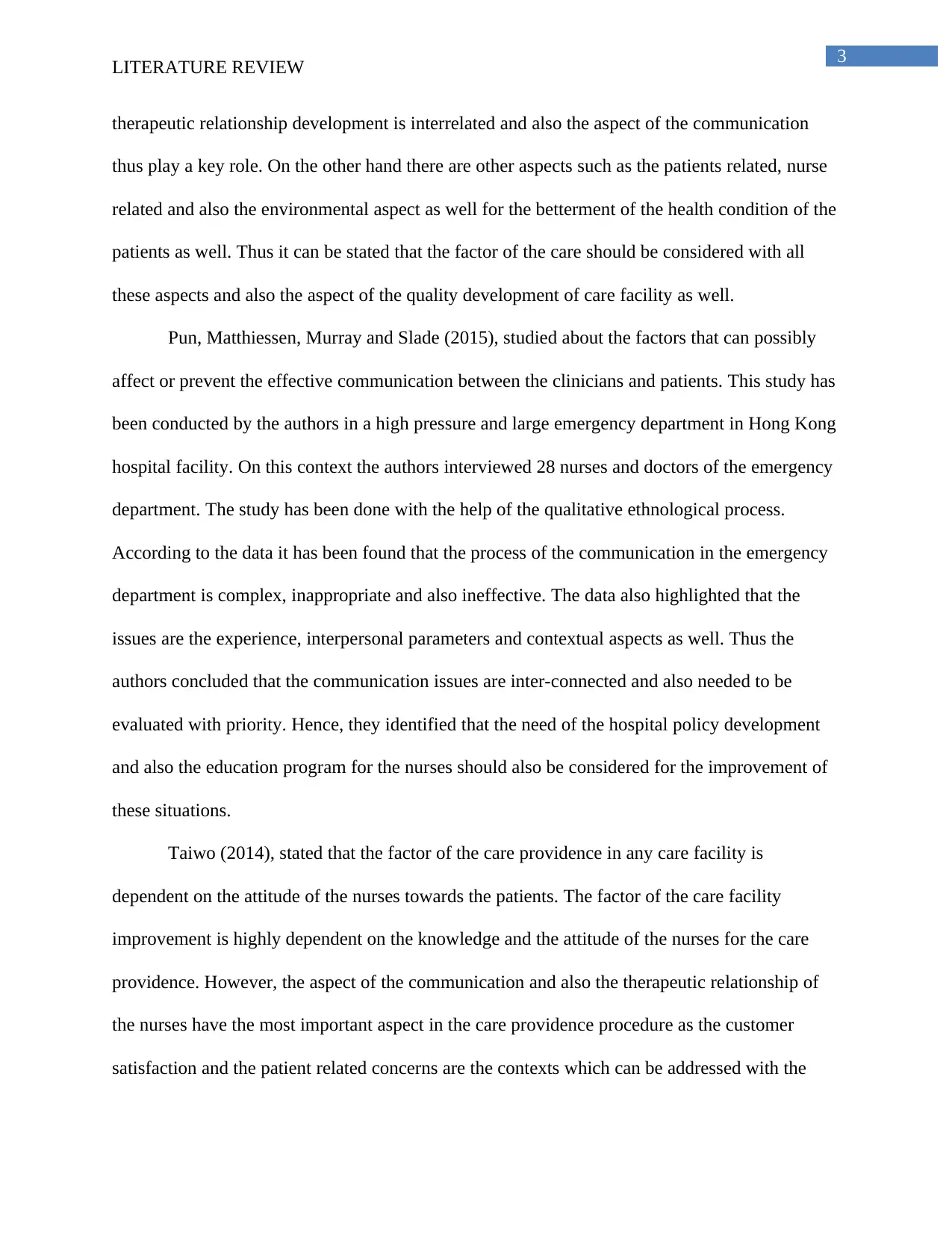
3
LITERATURE REVIEW
therapeutic relationship development is interrelated and also the aspect of the communication
thus play a key role. On the other hand there are other aspects such as the patients related, nurse
related and also the environmental aspect as well for the betterment of the health condition of the
patients as well. Thus it can be stated that the factor of the care should be considered with all
these aspects and also the aspect of the quality development of care facility as well.
Pun, Matthiessen, Murray and Slade (2015), studied about the factors that can possibly
affect or prevent the effective communication between the clinicians and patients. This study has
been conducted by the authors in a high pressure and large emergency department in Hong Kong
hospital facility. On this context the authors interviewed 28 nurses and doctors of the emergency
department. The study has been done with the help of the qualitative ethnological process.
According to the data it has been found that the process of the communication in the emergency
department is complex, inappropriate and also ineffective. The data also highlighted that the
issues are the experience, interpersonal parameters and contextual aspects as well. Thus the
authors concluded that the communication issues are inter-connected and also needed to be
evaluated with priority. Hence, they identified that the need of the hospital policy development
and also the education program for the nurses should also be considered for the improvement of
these situations.
Taiwo (2014), stated that the factor of the care providence in any care facility is
dependent on the attitude of the nurses towards the patients. The factor of the care facility
improvement is highly dependent on the knowledge and the attitude of the nurses for the care
providence. However, the aspect of the communication and also the therapeutic relationship of
the nurses have the most important aspect in the care providence procedure as the customer
satisfaction and the patient related concerns are the contexts which can be addressed with the
LITERATURE REVIEW
therapeutic relationship development is interrelated and also the aspect of the communication
thus play a key role. On the other hand there are other aspects such as the patients related, nurse
related and also the environmental aspect as well for the betterment of the health condition of the
patients as well. Thus it can be stated that the factor of the care should be considered with all
these aspects and also the aspect of the quality development of care facility as well.
Pun, Matthiessen, Murray and Slade (2015), studied about the factors that can possibly
affect or prevent the effective communication between the clinicians and patients. This study has
been conducted by the authors in a high pressure and large emergency department in Hong Kong
hospital facility. On this context the authors interviewed 28 nurses and doctors of the emergency
department. The study has been done with the help of the qualitative ethnological process.
According to the data it has been found that the process of the communication in the emergency
department is complex, inappropriate and also ineffective. The data also highlighted that the
issues are the experience, interpersonal parameters and contextual aspects as well. Thus the
authors concluded that the communication issues are inter-connected and also needed to be
evaluated with priority. Hence, they identified that the need of the hospital policy development
and also the education program for the nurses should also be considered for the improvement of
these situations.
Taiwo (2014), stated that the factor of the care providence in any care facility is
dependent on the attitude of the nurses towards the patients. The factor of the care facility
improvement is highly dependent on the knowledge and the attitude of the nurses for the care
providence. However, the aspect of the communication and also the therapeutic relationship of
the nurses have the most important aspect in the care providence procedure as the customer
satisfaction and the patient related concerns are the contexts which can be addressed with the
Paraphrase This Document
Need a fresh take? Get an instant paraphrase of this document with our AI Paraphraser
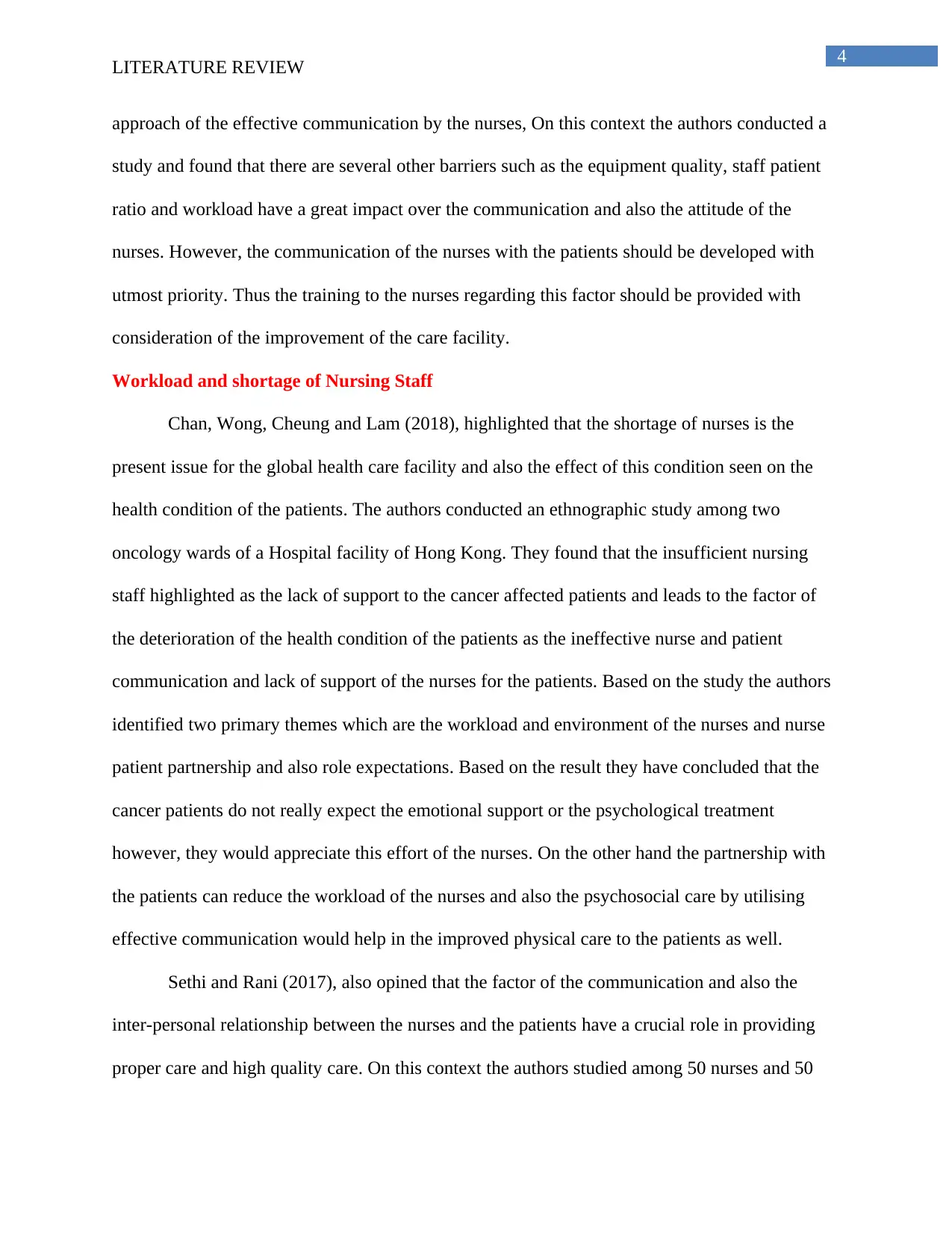
4
LITERATURE REVIEW
approach of the effective communication by the nurses, On this context the authors conducted a
study and found that there are several other barriers such as the equipment quality, staff patient
ratio and workload have a great impact over the communication and also the attitude of the
nurses. However, the communication of the nurses with the patients should be developed with
utmost priority. Thus the training to the nurses regarding this factor should be provided with
consideration of the improvement of the care facility.
Workload and shortage of Nursing Staff
Chan, Wong, Cheung and Lam (2018), highlighted that the shortage of nurses is the
present issue for the global health care facility and also the effect of this condition seen on the
health condition of the patients. The authors conducted an ethnographic study among two
oncology wards of a Hospital facility of Hong Kong. They found that the insufficient nursing
staff highlighted as the lack of support to the cancer affected patients and leads to the factor of
the deterioration of the health condition of the patients as the ineffective nurse and patient
communication and lack of support of the nurses for the patients. Based on the study the authors
identified two primary themes which are the workload and environment of the nurses and nurse
patient partnership and also role expectations. Based on the result they have concluded that the
cancer patients do not really expect the emotional support or the psychological treatment
however, they would appreciate this effort of the nurses. On the other hand the partnership with
the patients can reduce the workload of the nurses and also the psychosocial care by utilising
effective communication would help in the improved physical care to the patients as well.
Sethi and Rani (2017), also opined that the factor of the communication and also the
inter-personal relationship between the nurses and the patients have a crucial role in providing
proper care and high quality care. On this context the authors studied among 50 nurses and 50
LITERATURE REVIEW
approach of the effective communication by the nurses, On this context the authors conducted a
study and found that there are several other barriers such as the equipment quality, staff patient
ratio and workload have a great impact over the communication and also the attitude of the
nurses. However, the communication of the nurses with the patients should be developed with
utmost priority. Thus the training to the nurses regarding this factor should be provided with
consideration of the improvement of the care facility.
Workload and shortage of Nursing Staff
Chan, Wong, Cheung and Lam (2018), highlighted that the shortage of nurses is the
present issue for the global health care facility and also the effect of this condition seen on the
health condition of the patients. The authors conducted an ethnographic study among two
oncology wards of a Hospital facility of Hong Kong. They found that the insufficient nursing
staff highlighted as the lack of support to the cancer affected patients and leads to the factor of
the deterioration of the health condition of the patients as the ineffective nurse and patient
communication and lack of support of the nurses for the patients. Based on the study the authors
identified two primary themes which are the workload and environment of the nurses and nurse
patient partnership and also role expectations. Based on the result they have concluded that the
cancer patients do not really expect the emotional support or the psychological treatment
however, they would appreciate this effort of the nurses. On the other hand the partnership with
the patients can reduce the workload of the nurses and also the psychosocial care by utilising
effective communication would help in the improved physical care to the patients as well.
Sethi and Rani (2017), also opined that the factor of the communication and also the
inter-personal relationship between the nurses and the patients have a crucial role in providing
proper care and high quality care. On this context the authors studied among 50 nurses and 50
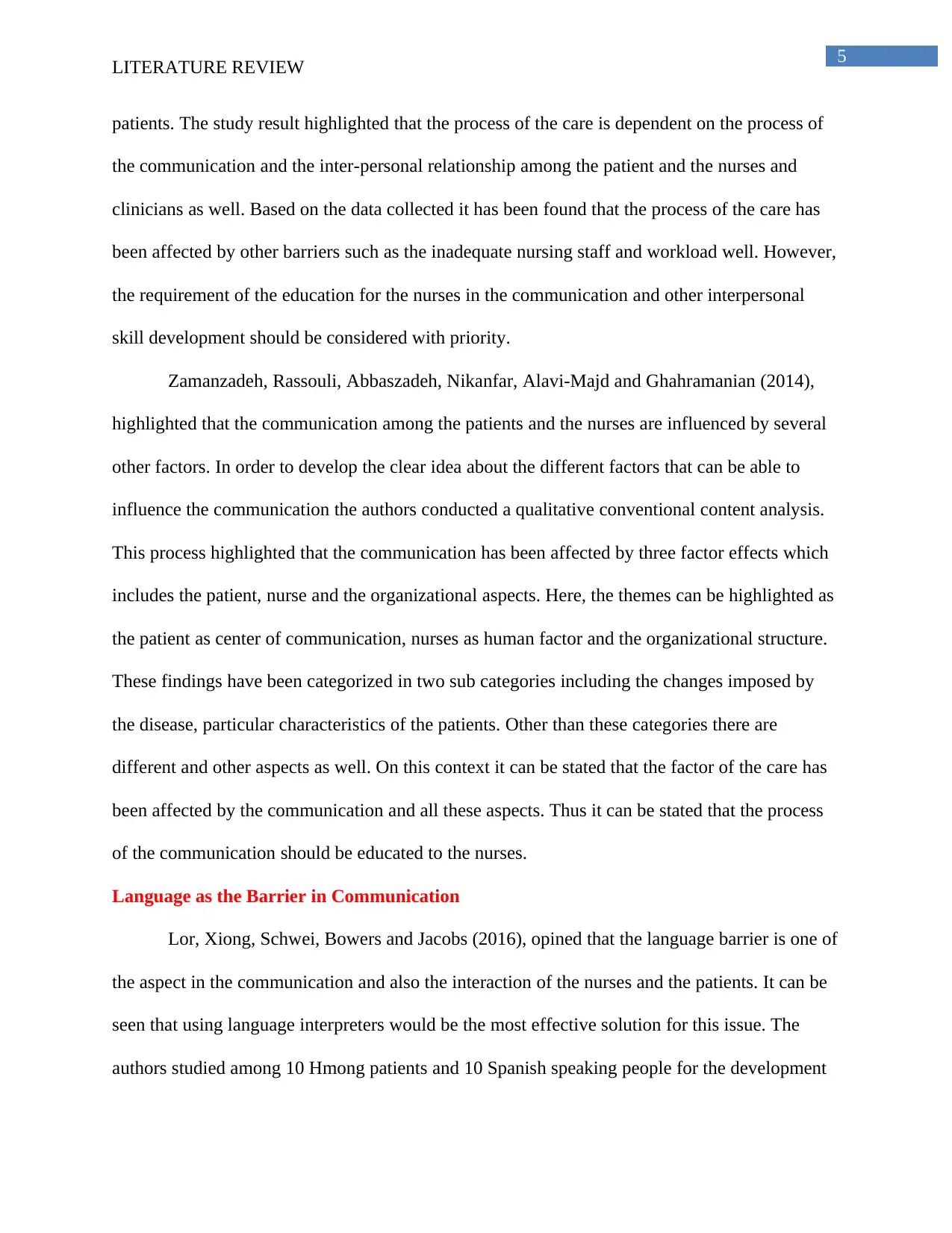
5
LITERATURE REVIEW
patients. The study result highlighted that the process of the care is dependent on the process of
the communication and the inter-personal relationship among the patient and the nurses and
clinicians as well. Based on the data collected it has been found that the process of the care has
been affected by other barriers such as the inadequate nursing staff and workload well. However,
the requirement of the education for the nurses in the communication and other interpersonal
skill development should be considered with priority.
Zamanzadeh, Rassouli, Abbaszadeh, Nikanfar, Alavi-Majd and Ghahramanian (2014),
highlighted that the communication among the patients and the nurses are influenced by several
other factors. In order to develop the clear idea about the different factors that can be able to
influence the communication the authors conducted a qualitative conventional content analysis.
This process highlighted that the communication has been affected by three factor effects which
includes the patient, nurse and the organizational aspects. Here, the themes can be highlighted as
the patient as center of communication, nurses as human factor and the organizational structure.
These findings have been categorized in two sub categories including the changes imposed by
the disease, particular characteristics of the patients. Other than these categories there are
different and other aspects as well. On this context it can be stated that the factor of the care has
been affected by the communication and all these aspects. Thus it can be stated that the process
of the communication should be educated to the nurses.
Language as the Barrier in Communication
Lor, Xiong, Schwei, Bowers and Jacobs (2016), opined that the language barrier is one of
the aspect in the communication and also the interaction of the nurses and the patients. It can be
seen that using language interpreters would be the most effective solution for this issue. The
authors studied among 10 Hmong patients and 10 Spanish speaking people for the development
LITERATURE REVIEW
patients. The study result highlighted that the process of the care is dependent on the process of
the communication and the inter-personal relationship among the patient and the nurses and
clinicians as well. Based on the data collected it has been found that the process of the care has
been affected by other barriers such as the inadequate nursing staff and workload well. However,
the requirement of the education for the nurses in the communication and other interpersonal
skill development should be considered with priority.
Zamanzadeh, Rassouli, Abbaszadeh, Nikanfar, Alavi-Majd and Ghahramanian (2014),
highlighted that the communication among the patients and the nurses are influenced by several
other factors. In order to develop the clear idea about the different factors that can be able to
influence the communication the authors conducted a qualitative conventional content analysis.
This process highlighted that the communication has been affected by three factor effects which
includes the patient, nurse and the organizational aspects. Here, the themes can be highlighted as
the patient as center of communication, nurses as human factor and the organizational structure.
These findings have been categorized in two sub categories including the changes imposed by
the disease, particular characteristics of the patients. Other than these categories there are
different and other aspects as well. On this context it can be stated that the factor of the care has
been affected by the communication and all these aspects. Thus it can be stated that the process
of the communication should be educated to the nurses.
Language as the Barrier in Communication
Lor, Xiong, Schwei, Bowers and Jacobs (2016), opined that the language barrier is one of
the aspect in the communication and also the interaction of the nurses and the patients. It can be
seen that using language interpreters would be the most effective solution for this issue. The
authors studied among 10 Hmong patients and 10 Spanish speaking people for the development
⊘ This is a preview!⊘
Do you want full access?
Subscribe today to unlock all pages.

Trusted by 1+ million students worldwide
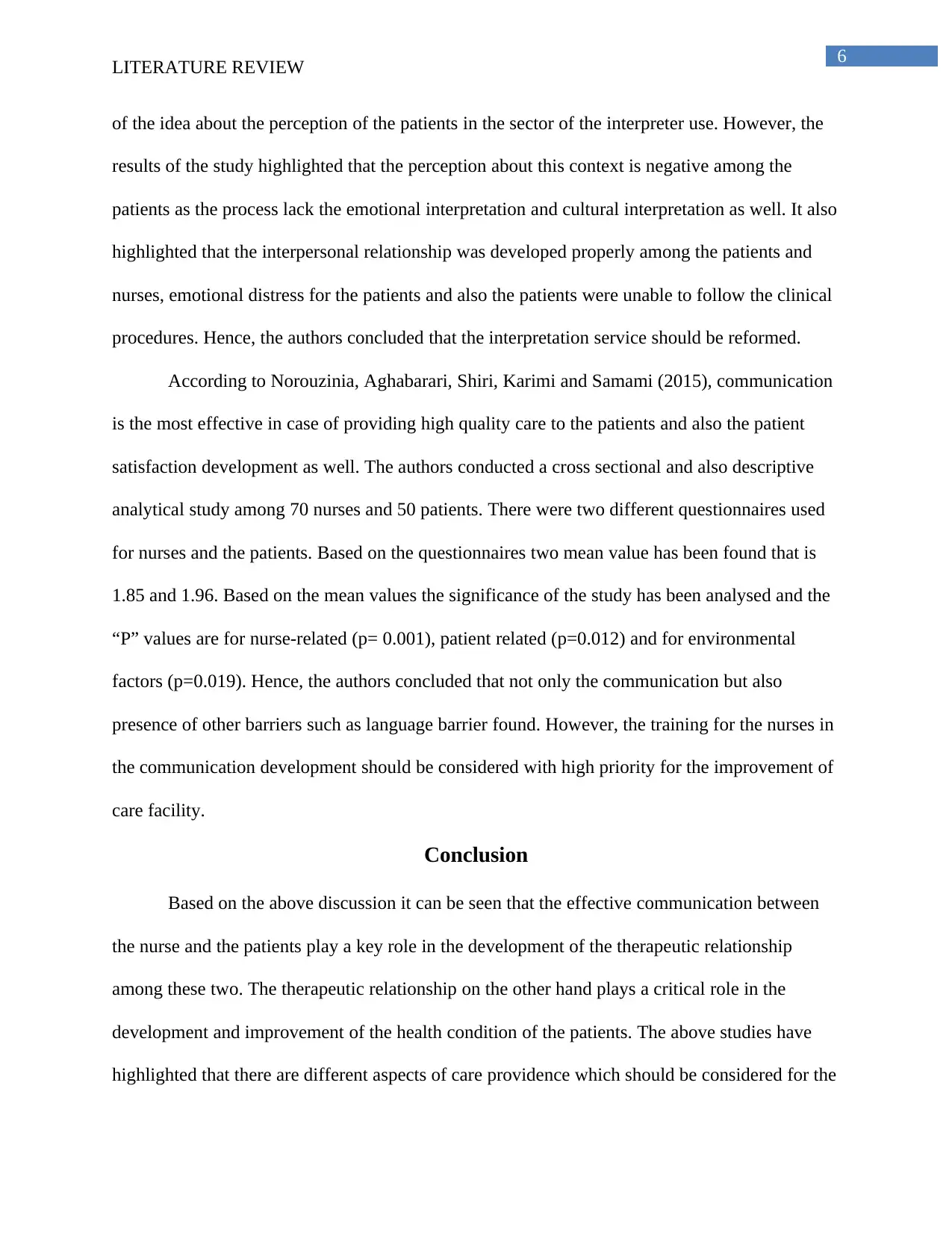
6
LITERATURE REVIEW
of the idea about the perception of the patients in the sector of the interpreter use. However, the
results of the study highlighted that the perception about this context is negative among the
patients as the process lack the emotional interpretation and cultural interpretation as well. It also
highlighted that the interpersonal relationship was developed properly among the patients and
nurses, emotional distress for the patients and also the patients were unable to follow the clinical
procedures. Hence, the authors concluded that the interpretation service should be reformed.
According to Norouzinia, Aghabarari, Shiri, Karimi and Samami (2015), communication
is the most effective in case of providing high quality care to the patients and also the patient
satisfaction development as well. The authors conducted a cross sectional and also descriptive
analytical study among 70 nurses and 50 patients. There were two different questionnaires used
for nurses and the patients. Based on the questionnaires two mean value has been found that is
1.85 and 1.96. Based on the mean values the significance of the study has been analysed and the
“P” values are for nurse-related (p= 0.001), patient related (p=0.012) and for environmental
factors (p=0.019). Hence, the authors concluded that not only the communication but also
presence of other barriers such as language barrier found. However, the training for the nurses in
the communication development should be considered with high priority for the improvement of
care facility.
Conclusion
Based on the above discussion it can be seen that the effective communication between
the nurse and the patients play a key role in the development of the therapeutic relationship
among these two. The therapeutic relationship on the other hand plays a critical role in the
development and improvement of the health condition of the patients. The above studies have
highlighted that there are different aspects of care providence which should be considered for the
LITERATURE REVIEW
of the idea about the perception of the patients in the sector of the interpreter use. However, the
results of the study highlighted that the perception about this context is negative among the
patients as the process lack the emotional interpretation and cultural interpretation as well. It also
highlighted that the interpersonal relationship was developed properly among the patients and
nurses, emotional distress for the patients and also the patients were unable to follow the clinical
procedures. Hence, the authors concluded that the interpretation service should be reformed.
According to Norouzinia, Aghabarari, Shiri, Karimi and Samami (2015), communication
is the most effective in case of providing high quality care to the patients and also the patient
satisfaction development as well. The authors conducted a cross sectional and also descriptive
analytical study among 70 nurses and 50 patients. There were two different questionnaires used
for nurses and the patients. Based on the questionnaires two mean value has been found that is
1.85 and 1.96. Based on the mean values the significance of the study has been analysed and the
“P” values are for nurse-related (p= 0.001), patient related (p=0.012) and for environmental
factors (p=0.019). Hence, the authors concluded that not only the communication but also
presence of other barriers such as language barrier found. However, the training for the nurses in
the communication development should be considered with high priority for the improvement of
care facility.
Conclusion
Based on the above discussion it can be seen that the effective communication between
the nurse and the patients play a key role in the development of the therapeutic relationship
among these two. The therapeutic relationship on the other hand plays a critical role in the
development and improvement of the health condition of the patients. The above studies have
highlighted that there are different aspects of care providence which should be considered for the
Paraphrase This Document
Need a fresh take? Get an instant paraphrase of this document with our AI Paraphraser
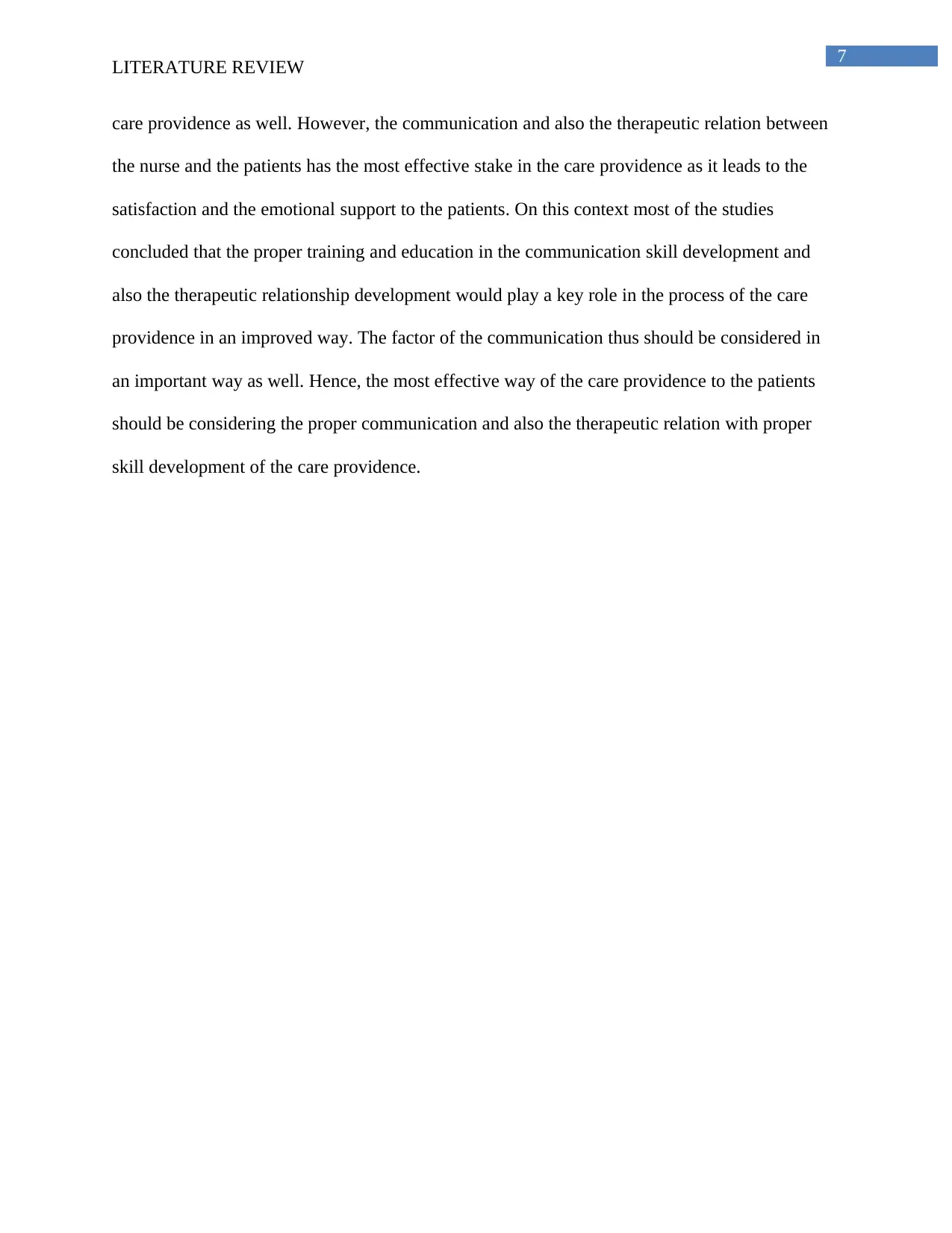
7
LITERATURE REVIEW
care providence as well. However, the communication and also the therapeutic relation between
the nurse and the patients has the most effective stake in the care providence as it leads to the
satisfaction and the emotional support to the patients. On this context most of the studies
concluded that the proper training and education in the communication skill development and
also the therapeutic relationship development would play a key role in the process of the care
providence in an improved way. The factor of the communication thus should be considered in
an important way as well. Hence, the most effective way of the care providence to the patients
should be considering the proper communication and also the therapeutic relation with proper
skill development of the care providence.
LITERATURE REVIEW
care providence as well. However, the communication and also the therapeutic relation between
the nurse and the patients has the most effective stake in the care providence as it leads to the
satisfaction and the emotional support to the patients. On this context most of the studies
concluded that the proper training and education in the communication skill development and
also the therapeutic relationship development would play a key role in the process of the care
providence in an improved way. The factor of the communication thus should be considered in
an important way as well. Hence, the most effective way of the care providence to the patients
should be considering the proper communication and also the therapeutic relation with proper
skill development of the care providence.
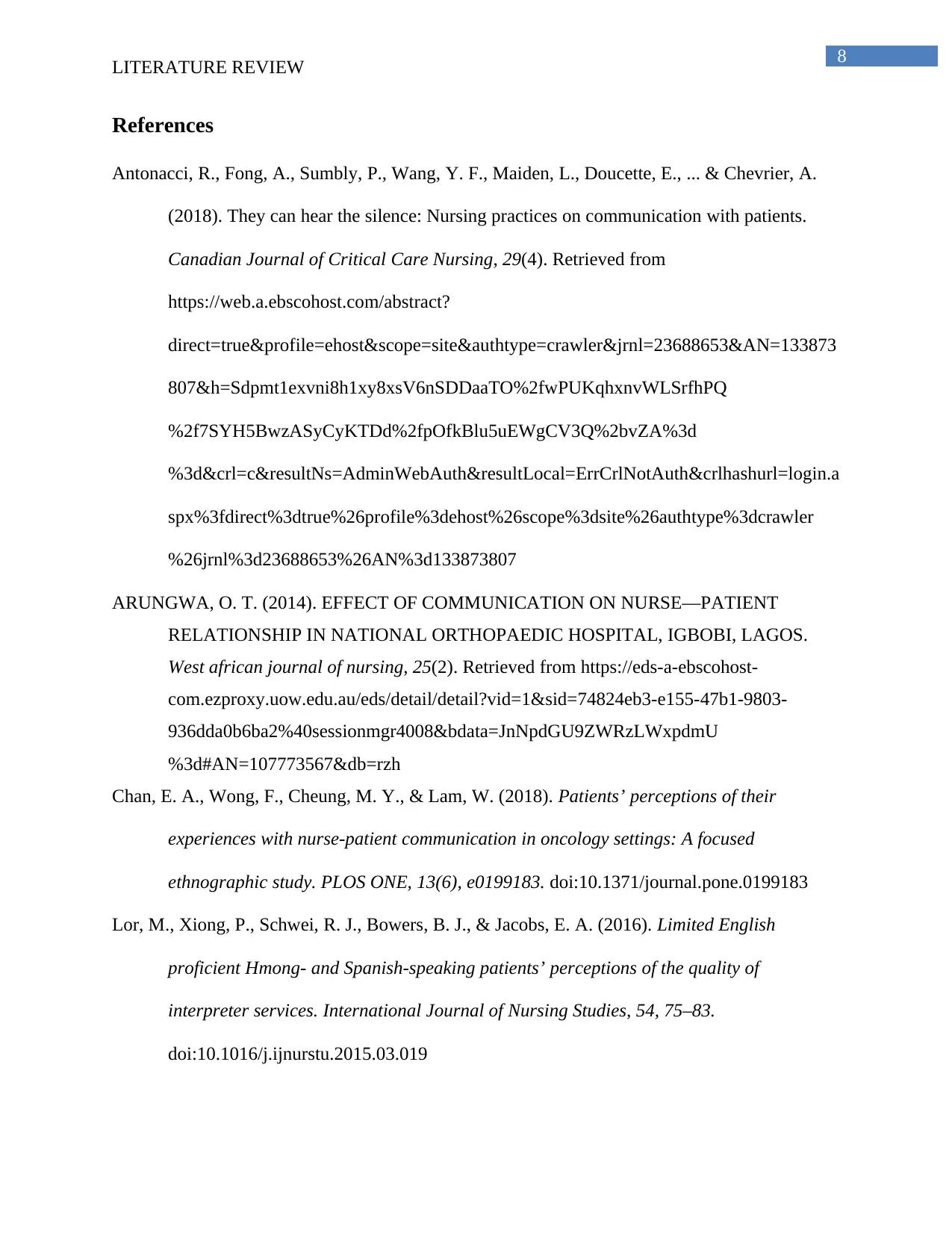
8
LITERATURE REVIEW
References
Antonacci, R., Fong, A., Sumbly, P., Wang, Y. F., Maiden, L., Doucette, E., ... & Chevrier, A.
(2018). They can hear the silence: Nursing practices on communication with patients.
Canadian Journal of Critical Care Nursing, 29(4). Retrieved from
https://web.a.ebscohost.com/abstract?
direct=true&profile=ehost&scope=site&authtype=crawler&jrnl=23688653&AN=133873
807&h=Sdpmt1exvni8h1xy8xsV6nSDDaaTO%2fwPUKqhxnvWLSrfhPQ
%2f7SYH5BwzASyCyKTDd%2fpOfkBlu5uEWgCV3Q%2bvZA%3d
%3d&crl=c&resultNs=AdminWebAuth&resultLocal=ErrCrlNotAuth&crlhashurl=login.a
spx%3fdirect%3dtrue%26profile%3dehost%26scope%3dsite%26authtype%3dcrawler
%26jrnl%3d23688653%26AN%3d133873807
ARUNGWA, O. T. (2014). EFFECT OF COMMUNICATION ON NURSE—PATIENT
RELATIONSHIP IN NATIONAL ORTHOPAEDIC HOSPITAL, IGBOBI, LAGOS.
West african journal of nursing, 25(2). Retrieved from https://eds-a-ebscohost-
com.ezproxy.uow.edu.au/eds/detail/detail?vid=1&sid=74824eb3-e155-47b1-9803-
936dda0b6ba2%40sessionmgr4008&bdata=JnNpdGU9ZWRzLWxpdmU
%3d#AN=107773567&db=rzh
Chan, E. A., Wong, F., Cheung, M. Y., & Lam, W. (2018). Patients’ perceptions of their
experiences with nurse-patient communication in oncology settings: A focused
ethnographic study. PLOS ONE, 13(6), e0199183. doi:10.1371/journal.pone.0199183
Lor, M., Xiong, P., Schwei, R. J., Bowers, B. J., & Jacobs, E. A. (2016). Limited English
proficient Hmong- and Spanish-speaking patients’ perceptions of the quality of
interpreter services. International Journal of Nursing Studies, 54, 75–83.
doi:10.1016/j.ijnurstu.2015.03.019
LITERATURE REVIEW
References
Antonacci, R., Fong, A., Sumbly, P., Wang, Y. F., Maiden, L., Doucette, E., ... & Chevrier, A.
(2018). They can hear the silence: Nursing practices on communication with patients.
Canadian Journal of Critical Care Nursing, 29(4). Retrieved from
https://web.a.ebscohost.com/abstract?
direct=true&profile=ehost&scope=site&authtype=crawler&jrnl=23688653&AN=133873
807&h=Sdpmt1exvni8h1xy8xsV6nSDDaaTO%2fwPUKqhxnvWLSrfhPQ
%2f7SYH5BwzASyCyKTDd%2fpOfkBlu5uEWgCV3Q%2bvZA%3d
%3d&crl=c&resultNs=AdminWebAuth&resultLocal=ErrCrlNotAuth&crlhashurl=login.a
spx%3fdirect%3dtrue%26profile%3dehost%26scope%3dsite%26authtype%3dcrawler
%26jrnl%3d23688653%26AN%3d133873807
ARUNGWA, O. T. (2014). EFFECT OF COMMUNICATION ON NURSE—PATIENT
RELATIONSHIP IN NATIONAL ORTHOPAEDIC HOSPITAL, IGBOBI, LAGOS.
West african journal of nursing, 25(2). Retrieved from https://eds-a-ebscohost-
com.ezproxy.uow.edu.au/eds/detail/detail?vid=1&sid=74824eb3-e155-47b1-9803-
936dda0b6ba2%40sessionmgr4008&bdata=JnNpdGU9ZWRzLWxpdmU
%3d#AN=107773567&db=rzh
Chan, E. A., Wong, F., Cheung, M. Y., & Lam, W. (2018). Patients’ perceptions of their
experiences with nurse-patient communication in oncology settings: A focused
ethnographic study. PLOS ONE, 13(6), e0199183. doi:10.1371/journal.pone.0199183
Lor, M., Xiong, P., Schwei, R. J., Bowers, B. J., & Jacobs, E. A. (2016). Limited English
proficient Hmong- and Spanish-speaking patients’ perceptions of the quality of
interpreter services. International Journal of Nursing Studies, 54, 75–83.
doi:10.1016/j.ijnurstu.2015.03.019
⊘ This is a preview!⊘
Do you want full access?
Subscribe today to unlock all pages.

Trusted by 1+ million students worldwide
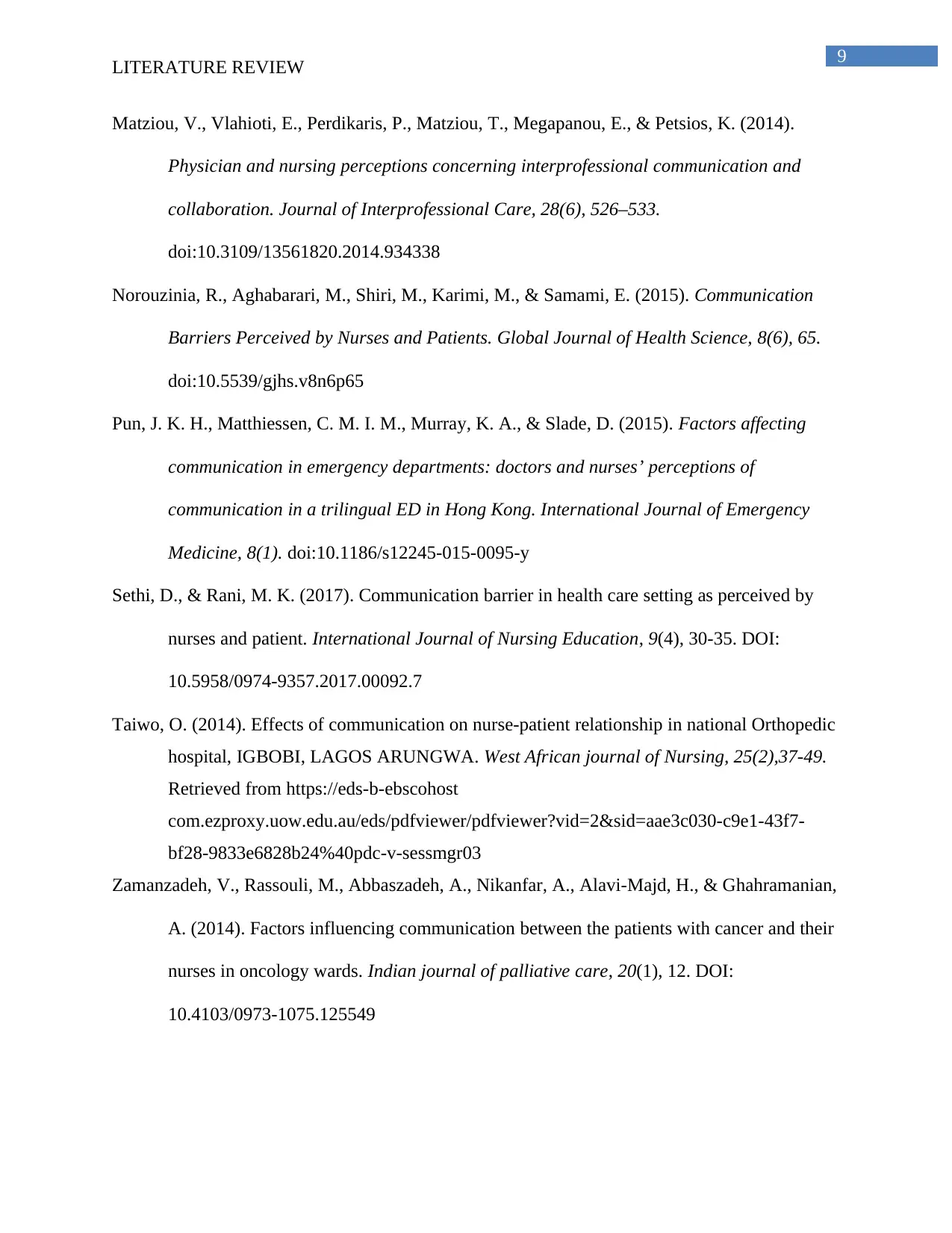
9
LITERATURE REVIEW
Matziou, V., Vlahioti, E., Perdikaris, P., Matziou, T., Megapanou, E., & Petsios, K. (2014).
Physician and nursing perceptions concerning interprofessional communication and
collaboration. Journal of Interprofessional Care, 28(6), 526–533.
doi:10.3109/13561820.2014.934338
Norouzinia, R., Aghabarari, M., Shiri, M., Karimi, M., & Samami, E. (2015). Communication
Barriers Perceived by Nurses and Patients. Global Journal of Health Science, 8(6), 65.
doi:10.5539/gjhs.v8n6p65
Pun, J. K. H., Matthiessen, C. M. I. M., Murray, K. A., & Slade, D. (2015). Factors affecting
communication in emergency departments: doctors and nurses’ perceptions of
communication in a trilingual ED in Hong Kong. International Journal of Emergency
Medicine, 8(1). doi:10.1186/s12245-015-0095-y
Sethi, D., & Rani, M. K. (2017). Communication barrier in health care setting as perceived by
nurses and patient. International Journal of Nursing Education, 9(4), 30-35. DOI:
10.5958/0974-9357.2017.00092.7
Taiwo, O. (2014). Effects of communication on nurse-patient relationship in national Orthopedic
hospital, IGBOBI, LAGOS ARUNGWA. West African journal of Nursing, 25(2),37-49.
Retrieved from https://eds-b-ebscohost
com.ezproxy.uow.edu.au/eds/pdfviewer/pdfviewer?vid=2&sid=aae3c030-c9e1-43f7-
bf28-9833e6828b24%40pdc-v-sessmgr03
Zamanzadeh, V., Rassouli, M., Abbaszadeh, A., Nikanfar, A., Alavi-Majd, H., & Ghahramanian,
A. (2014). Factors influencing communication between the patients with cancer and their
nurses in oncology wards. Indian journal of palliative care, 20(1), 12. DOI:
10.4103/0973-1075.125549
LITERATURE REVIEW
Matziou, V., Vlahioti, E., Perdikaris, P., Matziou, T., Megapanou, E., & Petsios, K. (2014).
Physician and nursing perceptions concerning interprofessional communication and
collaboration. Journal of Interprofessional Care, 28(6), 526–533.
doi:10.3109/13561820.2014.934338
Norouzinia, R., Aghabarari, M., Shiri, M., Karimi, M., & Samami, E. (2015). Communication
Barriers Perceived by Nurses and Patients. Global Journal of Health Science, 8(6), 65.
doi:10.5539/gjhs.v8n6p65
Pun, J. K. H., Matthiessen, C. M. I. M., Murray, K. A., & Slade, D. (2015). Factors affecting
communication in emergency departments: doctors and nurses’ perceptions of
communication in a trilingual ED in Hong Kong. International Journal of Emergency
Medicine, 8(1). doi:10.1186/s12245-015-0095-y
Sethi, D., & Rani, M. K. (2017). Communication barrier in health care setting as perceived by
nurses and patient. International Journal of Nursing Education, 9(4), 30-35. DOI:
10.5958/0974-9357.2017.00092.7
Taiwo, O. (2014). Effects of communication on nurse-patient relationship in national Orthopedic
hospital, IGBOBI, LAGOS ARUNGWA. West African journal of Nursing, 25(2),37-49.
Retrieved from https://eds-b-ebscohost
com.ezproxy.uow.edu.au/eds/pdfviewer/pdfviewer?vid=2&sid=aae3c030-c9e1-43f7-
bf28-9833e6828b24%40pdc-v-sessmgr03
Zamanzadeh, V., Rassouli, M., Abbaszadeh, A., Nikanfar, A., Alavi-Majd, H., & Ghahramanian,
A. (2014). Factors influencing communication between the patients with cancer and their
nurses in oncology wards. Indian journal of palliative care, 20(1), 12. DOI:
10.4103/0973-1075.125549
1 out of 10
Related Documents
Your All-in-One AI-Powered Toolkit for Academic Success.
+13062052269
info@desklib.com
Available 24*7 on WhatsApp / Email
![[object Object]](/_next/static/media/star-bottom.7253800d.svg)
Unlock your academic potential
Copyright © 2020–2025 A2Z Services. All Rights Reserved. Developed and managed by ZUCOL.




